According provided by Lens SIGMA 'C' 17-70mm 1: 2.8-4 DC OS HSM MACRO (for Nikon) huge thanks to Yuri Segeda.
Navigation
- In short
- Sigma C line (Contemporary)
- History
- Main Specifications
- Assembly
- Focusing
- Diaphragm
- Stabilizer
- Compatibility and Features
- Image quality
- Sample Photos
- My personal experience with the lens
- Alternatives
- Prices
- Results
- User Comments
- Add your review or question on the lens
This review presents a version of the SIGMA class 17-70 / 2.8-4 lens for Nikon cameras. Please note that the SIGMA 17-70mm 1: 2.8-4 DC OS HSM MACRO lens exists in the options for Canon, Pentax, Sony and Sigma cameras. And also note that under the name SIGMA 17-70 there are several more similar lenses that preceded the lens from this review and a list of which is listed in the alternative section.
In short
SIGMA C 17-70mm 1: 2.8-4 DC OS HSM MACRO is considered a universal lens for cropped cameras with APS-C sensor. The lens has a 4.1X zoom, which allows you to use it for a large number of standard photo tasks. First of all, it’s interesting with the built-in image stabilizer and an enlarged, compared to other similar lenses, aperture.
This lens is a balanced solution in terms of price and quality and can serve as a good alternative to original similar lenses. Nikon 16-80 / 2.8-4E VR и Nikon 16-85 / 3.5-5.6G VR. And also SIGMA C 17-70mm 1: 2.8-4 DC OS HSM MACRO can definitely be recommended as a replacement for regular universal lenses of the 18-55 / 3.5-5.6 class.
Sigma C line (Contemporary)
Line of lenses Sigma C (Sigma Contemporary) It comprises:
DG
Lenses for full-frame SLR cameras (series DG), for Nikon F, Canon EF and Sigma SA mounts:
- SIGMA 100-400 mm 1: 5-6.3 DG OS | C (Contemporary), 21/15, February 2017 [AliExpress]
- SIGMA 150-600 mm 1: 5-6.3 DG OS MACRO | C (Contemporary), 20/14, September 2014 [AliExpress]
DG DN
Lenses for full-frame mirrorless cameras (series DG DN) for bayonets Sony E и Leica l. SIGMA I - compact premium prime lenses:
- Sigma 17 mm 1: 4 DG DN C | (Contemporary), 9/8 April 2023 [I] [AliExpress]
- Sigma 20 mm 1: 2 DG DN C | (Contemporary), 13/11, February 2022 [I] [Aliexrepss]
- Sigma 24 mm 1: 2 DG DN C | (Contemporary), 13/11 September 2021 [I] [AliExpress]
- Sigma 24 mm 1: 3.5 DG DN C | (Contemporary), 10/8, December 2020 [I] [AliExpress]
- Sigma 35 mm 1: 2 DG DN C | (Contemporary), 10/9, December 2020 [I] [AliExpress]
- Sigma 45 mm 1: 2.8 DG DN C | (Contemporary), 8/7, July 2019 [I][AliExpress]
- Sigma 50 mm 1: 2 DG DN C | (Contemporary), 11/9, April 2023 [I] [AliExpress]
- Sigma 65 mm 1: 2 DG DN C | (Contemporary), 12/9, December 2020 [I] [AliExpress]
- Sigma 90 mm 1: 2.8 DG DN C | (Contemporary), 11/10, September 2021 [I] [AliExpress]
- Sigma 16-28 mm 1: 2.8 DG DN C | (Contemporary), 16/11, June 2022 [AliExpress]
- Sigma 28-70 mm 1: 2.8 DG DN C | (Contemporary), 16/12, February 2021 [AliExpress]
- Sigma 100-400 1: 5-6.3 DG DN OS C | (Contemporary), 22/16, June 2020 [AliExpress]
DC
Lenses for cropped SLR cameras (series DC) for Nikon F, Canon EF, Sigma SA, Sony A, Pentax K:
- SIGMA 17-70 mm 1: 2.8-4 DC OS MACRO | C (Contemporary), 16/14, September 2012 [AliExpress]
- SIGMA 18-200 mm 1: 3.5-6.3 DC OS MACRO | C (Contemporary), 16/13, January 2014
- SIGMA 18-300 mm 1: 3.5-6.3 DC OS MACRO | C (Contemporary), 17/13, September 2014 [AliExpress]
DC DN
Lenses for cropped mirrorless cameras (series DC DN) for bayonets fujifilm x, Sony E, Leica l, Canon EOS M, Canon RF-S (expected summer 2024), Nikon Z, Micro 4 / 3:
- SIGMA 16 mm 1: 1.4 DC DN | C (Contemporary), 16/13, October 2017 [X, E, L, M, RF-S, Z, MFT] [AliExpress]
- SIGMA 23 mm 1: 1.4 DC DN | C (Contemporary), 13/10, April 2023 [X, E, L, RFS] [Alixexpress]
- SIGMA 30 mm 1: 1.4 DC DN | C (Contemporary), 9/7, September 2016 [X, E, L, M, RF-S, Z, MFT] [AliExpress]
- SIGMA 56 mm 1: 1.4 DC DN | C (Contemporary), 10/6, September 2018 [X, E, L, M, RF-S, Z, MFT] [AliExpress]
- SIGMA 10-18 mm 1:2.8 DC DN C (Contemporary), 13/10, October 2023 [X, E, L, RF-S]
- SIGMA 18-50 mm 1: 2.8 DC DN | C (Contemporary), 13/10, October 2021 [X, E, L, RF-S] [AliExpress]
Additionally, you can look at all lenses SIGMA ART (A) и all lenses SIGMA SPORT (S). Here here there is a short video about the rulers and markings of Sigma lenses.
History
Sigma 17-70 / 2.8-4 (4.5) has four main models:
- Sigma DC 17-70mm 1: 2.8-4.5Scheme 15/12, since February 2006
- Sigma DC 17-70mm 1: 2.8-4.5 MACRO HSMDiagram 15/12, from July 2007, for Nikon cameras only
- Sigma DC 17-70mm 1: 2.8-4 MACRO HSM OSScheme 17/13, from December 2009
- Sigma DC 17-70mm 1: 2.8-4 C, [Macro, HSM, OS, Contemporary]Scheme 16/14, from September 2012
Separately, there is a line of DC EX / ART series fixed aperture lenses (see the list in the 'Alternatives' section).
Main technical characteristics of Sigma DC 17-70mm 1: 2.8-4.5 MACRO HSM:
| Review Instance Name | The lens barrel bears the following inscriptions 'SIGMA C 17-70mm 1: 2.8-4 DC Ø 72 LENS MADE IN JAPAN' |
| Basic properties |
|
| Front Filter Diameter | 72 mm |
| Focal length | 17-70 mm EGF for Nikon DX cameras is 25.5-105 mm |
| Zoom ratio | 4.12 X (usually rounded to 4) |
| Designed by | for Nikon DX digital cameras, there are modifications for other systems
|
| Number of aperture blades | 7 rounded petals |
| Tags | focusing distance in meters and feet, focal lengths for 17, 24, 28, 35, 50, 70 mm, mark of bayonet mount and mount / fix hood. There are zoom marks depending on the focal length:
|
| Diaphragm | control is via the camera menu (analog Nikon G - lens type)
|
| MDF | 0.22 m, maximum magnification ratio 1: 2.8 |
| The weight | 465 g |
| Optical design | 16 elements in 14 groups, 3 aspherical ASP elements (aspherical elements shown in pink on the optical diagram) and 1 low dispersion element SLD (shown in blue on the optical diagram) and 2 FLD elements (shown in yellow on the optical diagram)
Image of optical circuit clickable |
| Lens hood | LH780-03, Bayonet type, plastic, with the possibility of installation in transport mode |
| Manufacturer country | LENS MADE IN JAPAN (Lens made in Japan) |
| Production period | Since September 2012 |
| Price |
The lens barrel has a small 'C' letter written in a silver circle. This letter is responsible for the class of the lens according to the modern gradation of Sigma lenses. 'C' is an abbreviation for 'Contemporary', these lenses have a modern body, not the most outstanding aperture parameters and are intended primarily for amateur photographers :).
Assembly
SIGMA C 17-70mm 1: 2.8-4 DC OS HSM MACRO Available with 2012 years... Assembled in Japan. The lens is pleasant and weighty to the touch, its weight is already 465 grams. The lens uses large 72mm filters. Personally, I would prefer it instead of 72mm to go straight to the 'professional' size of 77mm.
The body is completely black and lacks the characteristic Sigma velvet finish. The focusing and zoom rings are rubberized. The lens barrel is made of a new composite material - TSC — Thermally Sbackgammon Composite (Thermally Stable Composite), which is less sensitive to temperature changes than conventional polycarbonate. Such a composite avoids deformation of the case with a large change in ambient temperature. From this material, Sigma makes its 'ART' series lenses such as Sigma 35mm 1: 1.4 DG A HSM. In addition, the lens has metal bayonet mount.
There is a bayonet mount mark and a mark on the case for quick installation of the hood. The lens uses a plastic lens hood SIGMA LH780-03, which is fixed in special grooves located near the front lens of the lens. The hood can be installed in the opposite direction for transportation. In this position, access to the focus ring at 17 mm focal length is lost.
The copy that I had for review does not have obvious signs of wear or long use, but, nevertheless, the lens barrel (trunk) spontaneously changes its size under its own weight. In previous versions of the lens, there was a focal length lock that prevented unauthorized changes to the lens size. It is not known why the SIGMA C 17-70mm 1: 2.8-4 DC OS HSM MACRO had such a retainer removed. The retractable body frame (trunk) consists of 2 sections. The sections are strong enough to the touch, without any backlashes. From the side of the rear lens, you can see part of the insides of the lens - gears, cables, boards.
SIGMA C 17-70mm 1: 2.8-4 DC OS HSM MACRO comes in a small cardboard box.
Focusing
To focus, the lens uses a special ultrasonic focusing motor 'HSM' (Hyper Sonic Motor). Although it is written everywhere that this technology uses silent focusing, in fact, the noise from focusing SIGMA C 17-70mm 1: 2.8-4 is heard. At first, I even thought that the lens doesn’t have any “HSM”, and a regular micro-motor is used for focusing, especially since there are no “HSM” inscriptions on the lens body. In general, the lens focuses quite quietly, but not silently.
Focus speed is enough high. Focusing time from infinity to MDF and back is approximately equal to that of the lens Nikon DX AF-S Nikkor 16-85mm 1: 3.5-5.6G ED VR SWM IF Aspherical. While working on camera Nikon D80 I did not observe any obvious inaccuracies or focusing errors, everything worked as expected.
Focusing on the SIGMA C 17-70mm 1: 2.8-4 internal - when focusing, neither the front nor the rear lens rotates, and the lens itself does not change its size when focusing. But the trouble is that during auto focus, the focus ring rotates and cannot be touched. In such lenses from Nikon / Canon, the focus ring remains stationary during auto focus.
In manual focus mode, the focus ring rotates 75 degrees. Focus ring travel is very smooth, but still manual focus is inconvenient.
The lens has a focus distance scale with marks in meters and feet. The scale is plotted on the focus ring. The minimum focusing distance is only 22 cm (the distance from the camera’s matrix to the subject). With such an MDF, the maximum magnification factor is 1: 2.8 (on the official website 1: 2.9 indicated). Thus, the lens allows you to shoot amateur 'close', and on the rim of the case you can find the inscription' Macro '. The retractable case bezel has marks indicating the current magnification factor: 1: 5.8, 1: 5.1, 1: 4.3, 1: 3.4 and 1: 2.8.
Note: if you shoot 'macro objects' located on a horizontal surface, then when focusing at the minimum possible distance, you can hook the body frame to this very surface.
The lens has focus mode switch 'AF / MF FOCUS'. For manual focusing, the lens must be set to 'MF' mode, otherwise the focusing motor may be damaged. Unfortunately, unlike many Nikon / Canon lenses of this type, the SIGMA C 17-70mm 1: 2.8-4 does not support continuous manual focusing.
Also, note that as the focal length changes, the rear lens moves in the middle of the lens barrel like a pump - drawing in and out air. This behavior of the rear lens is called 'effect' of a vacuum cleaner, which can increase the amount of dust that accumulates in the camera.
Diaphragm
The lens diaphragm consists of 7 petals that form a fairly even hole (example on f / 8).
A distinctive feature of the lens is that at 17 mm focal length SIGMA C 17-70mm 1: 2.8-4 can use the aperture F / 2.8. Because of this, many users attribute this lens to aperture optics. But it’s enough to at least slightly increase the focal length, as the maximum aperture becomes equal to F / 3.0 and decreases to F / 4.0 by 70 mm of focal length.
There are marks with a focal length on the zoom ring, the following is a list with the minimum numbers F available for these marks:
- 17 mm - F / 2.8
- 24 mm - F / 3.2
- 28 mm - F / 3.3
- 35 mm - F / 3.5
- 50 mm - F / 4
- 70 mm - F / 4
Aperture closes to F / 22 over the entire range of focal lengths.
Stabilizer
SIGMA C 17-70mm 1: 2.8-4 DC OS HSM MACRO has an integrated image stabilizer. I could not find official information about how many steps shutter speed can compensate for the stabilizer. In any case, the stabilizer works well.
On the case there is a stabilizer operating mode switch 'OS ON / OFF'. Where 'OS' is short for 'Optical Stabilizer'.
The stabilizer has its own characteristics. If you listen to the inside of the lens, you can hear a slight noise in the middle of the lens, even if the stabilizer is in the 'OFF' position. By pressing the focus / metering button exposure the noise just intensifies - apparently the stabilizer starts to work at full capacity. When the camera is turned off, even if the stabilizer is in the 'OFF' position, JVI noticeable image twitching and noise from lens parking is a sign that the gimbal has turned off 'one more time'. Also, on my camera Nikon D80, on which I tested this lens, SIGMA C 17-70mm 1: 2.8-4 DC OS HSM MACRO does not automatically turn off the metering after the time interval specified in the settings. Thus, the stabilizer and exposure meter with the camera turned on continues to work continuously, which can adversely affect the battery charge level. I observed a similar unusual behavior of the stabilizer on the lens Sigma Zoom 17-50mm 1: 2.8 EX DC OS HSM.
In the version for Sony and Pentax cameras, the lens does not have a built-in stabilizer, since the stabilizer is already present in the cameras of these manufacturers themselves.
Compatibility and Features
Nikon does not have a complete analogue of SIGMA C 17-70mm 1: 2.8-4 DC OS HSM MACRO. The most similar to him can be considered Nikon DX AF-S Nikkor 16-85mm 1: 3.5-5.6G ED VR SWM IF Aspherical и Nikon 18-70mm AF-S 3.5-4.5G ED-IF DX.
SIGMA C 17-70mm 1: 2.8-4 DC OS HSM MACRO is compatible with all Nikon digital SLR cameras. Auto focus with the lens will work even on the simplest Nikon DX cameras without a focus motor... The lens does not have a diaphragm control ring, conveys the value of the focusing distance and is no different from the 'native' Nikon Nikkor lenses.
The prefix 'DC' in the lens name means that SIGMA C 17-70mm 1: 2.8-4 DC OS HSM MACRO is designed to work with cropped cameras. Nikon DX. EGF with such cameras will be 25,5-105 mm.
SIGMA C 17-70mm 1: 2.8-4 DC OS HSM MACRO supports working with SIGMA USB Dock stations to fine tune the lens and update its firmware.
Image quality
3 aspherical, 1 SLD and 2 FLD elements in the optical scheme of the lens, which consists of 16 elements in 14 groups, are trying to fight for good image quality. The fight goes for every pixel :).
At 17 mm and F / 2.8, the sharpness is not very good, but I was pleased that the edges and corners of the image do not sag as much as on many other lenses. If you cover the diaphragm, then the sharpness becomes very even nothing throughout the image field. But at 70 mm and F / 4.0, the sharpness is already sufficient for shooting most tasks.
Judging by high standards, in terms of resolution, the SIGMA C 17-70mm 1: 2.8-4 is not much ahead of standard lenses of the 18-55/105/135/200 class. On my 'large pixel' camera Nikon D80 I hardly achieved excellent sharpness even on covered apertures, the sharpness increases slightly with increasing F.
Distortion and vignetting at the proper level for this type of lens. It is a pity, but it was not possible to get rid of chromatic aberrations either, most of them by 17 mm and F / 2.8.
But in the back and side light, the lens behaves well, only occasionally creating small glare in the pictures when shooting against strong light sources.
In general, the lens showed the expected image quality for its class.
Sample Photos
You can download RAW source files at this link (59 files in .'NEF 'format, 504 MB). All photos were shot using protective filter HOYA HMC 72mm UV (0) made in Japan, this filter is noticeably 'yellow' (see). Previews in the gallery - on-camera JPEG from the camera Nikon D80.
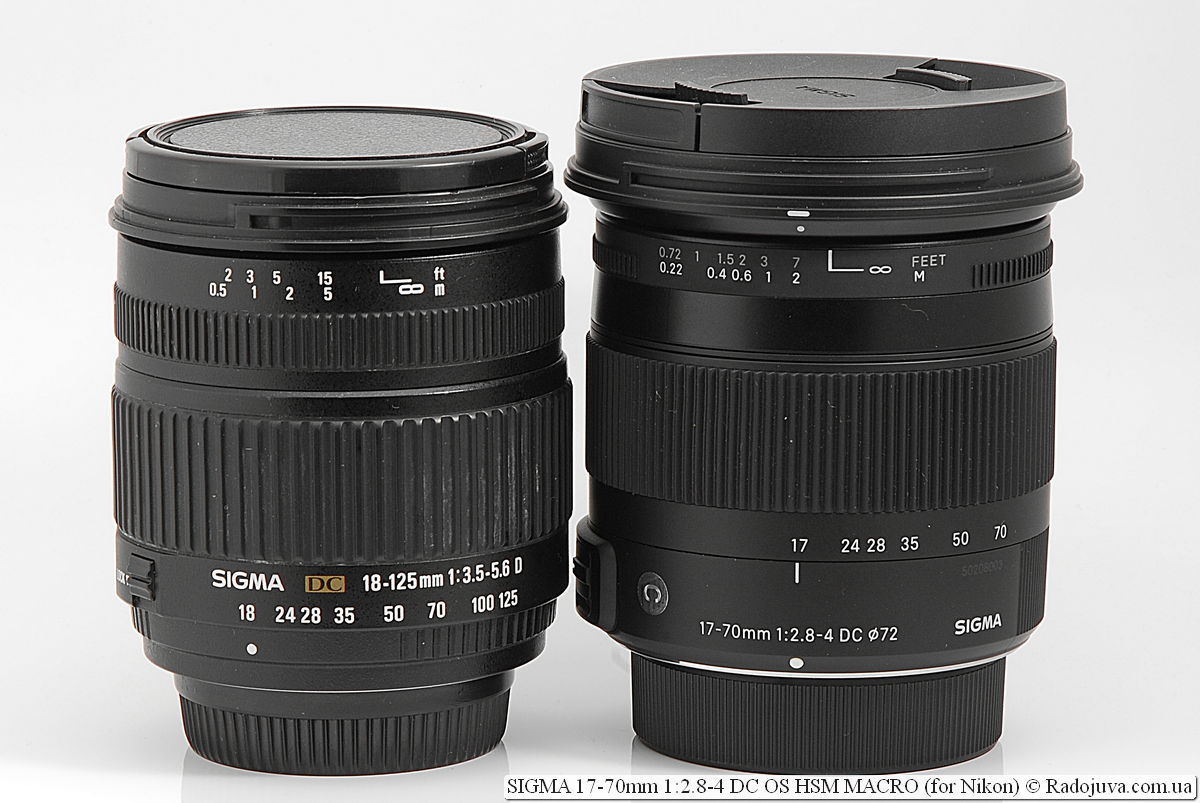
Sigma DC 18-125mm 1: 3.5-5.6 D and SIGMA C 17-70mm 1: 2.8-4 DC OS HSM MACRO
My experience
SIGMA C 17-70mm 1: 2.8-4 DC OS HSM MACRO nice lens. Personally, I was only a little surprised by the rotating focus ring during auto focus, the unusual behavior of the stabilizer and the relatively large weight. And, of course, I would like better sharpness from a lens with so many special elements in the optical design. Given the considerable cost of the lens, I would have bypassed it, and instead looked away Sigma Zoom 17-50mm 1: 2.8 EX DC OS HSM.
SIGMA C 17-70mm 1: 2.8-4 may be a good replacement for a whale lens type Nikon 18-55mm 1: 3.5-5.6GII VR II AF-S DX Nikkor и Canon Zoom Lens EF-S 18-55mm 1: 3.5-5.6 IS STM. I would refuse to use the SIGMA C 17-70mm 1: 2.8-4 DC OS HSM MACRO as a lens for some important events. But for simple shooting for every day, this lens is just right.
All fast universal zoom lenses
Below is a list of all such aperture-type universal zoom autofocus lenses for SLR and mirrorless cameras with an APS-C sensor or less.
Tokina (DX, various mounts)
- Tokina AT-X PRO SD 16-50 F2.8 DX Internal Focus, model AT-X 165 PRO DX, for Canon (C/EF version) and Nikon (N/AIS version), from July 2006. Optical design is the same as Pentax SMC DA* 16-50mm f/2.8 ED AL (IF) SDM
Tamron (DI II, DI III-A, various mounts)
- Tamron Aspherical LD XR DI II SP AF 17-50 mm 1: 2.8 [IF], model A16 N / E / P / S (under Nikon [N], Canon [E], Pentax [P], Sony / Minolta [S]), since February 2006. Produced in Japan, China and Vietnam
- promaster DIGITAL XR EDO AF Ashperical LD [IF] 17-50 mm 1: 2.8 MACROprevious lens under the brand Promaster
- Tamron Aspherical LD XR DI II SP AF 17-50 mm 1: 2.8 [IF], model A16 NII (only for Nikon cameras), since March 2008
- Tamron Di II SP 17-50 mm F / 2.8 VC B005, model B005 E / NII (for Canon [E] or Nikon [NII]), from September 2009, Japan or China)
- Tamron 17-70 mm F / 2.8 Di III-A VC RXD Model B070, Model B070, Sony E only, from December 2020
Sigma (DC, different mounts)
With constant maximum aperture (DC EX and DC ART series):
- Sigma DC ZOOM 18-50mm 1: 2.8 EX (+ -D), since July 2004, for Sigma SA, Nikon F, Canon EFS, Pentax K. The version for the '4/3' system has been available since February 2006 (not mass-produced). The version for Nikon in its name includes the prefix 'D'.
- Sigma dc 18-50mm 1: 2.8 EX MACRO, since September 2006, for Sigma SA, Nikon F, Canon EFS, Pentax K, 4/3
- Sigma dc 18-50mm 1: 2.8 EX MACRO HSM, since June 2007, for Nikon DX cameras only (Nikon F mount)
- Sigma dc 17-50mm 1: 2.8 ZOOM EXOS HSM, from February 2010, for Sigma SA, Nikon F, Canon EFS, Pentax K, Sony / Minotla A
- Sigma dc 18-35mm F1.8 A [ART, HSM], from April 2013, for Sigma SA, Nikon F, Canon EFS, Pentax K, Sony / Minotla A
- SIGMA DC 18-50 mm 1: 2.8 DN C [Contemporary], since Oct 2021, for Sony E, Leica L
With variable maximum aperture (DC and DC Contemporary series):
- Sigma dc 17-70mm 1:2.8-4.5, February 2006, for Sigma SA, Nikon F, Canon EFS, Pentax K, Sony / Minotla A
- Sigma dc 17-70mm 1:2.8-4.5 MACRO HSM, from July 2007, for Nikon DX cameras only (Nikon F mount)
- Sigma dc 17-70mm 1:2.8-4 MACRO HSM OS, from December 2009, for Sigma SA, Nikon F, Canon EFS, Pentax K, Sony / Minotla A
- Sigma dc 17-70mm 1:2.8-4 C, [MACRO, OS, HSM, Contemporary], from September 2012, for Sigma SA, Nikon F, Canon EFS, Pentax K, Sony / Minotla A
- Sigma dc 18-50mm 1:2.8-4.5 HSM OS ZOOM, from March 2009, for Sigma SA, Nikon F, Canon EFS, Pentax K, Sony / Minotla A
Nikon (DX, F mount)
- Nikon DX VR AF-S Nikkor 16-80mm 1:2.8-4E ED N, Nikon F mount, from July 2015
- Nikon DX AF-S Nikkor 17-55mm 1: 2.8G ED IF SWM, Nikon F mount, from July 2003
Pentax (DA, Q, K and Q mounts)
- Pentax SMC DA * 16-50 mm 1:2.8 ED AL (IF) SDM, Pentax KAF2 mount, since February 2007. Optical design is similar to the lens Tokina AT-X PRO SD 16-50 F2.8 DX Internal Focus (joint development of Tokina and Pentax)
- HD PENTAX-DA * 1: 2.8 16-50 mm ED PLMAW, from July 2021, Pentax KAF4 mount
- HD Pentax-DA 1: 2.8-4 20-40 mm ED Limited DC WR, Pentax KAF3 mount, black or silver body, from November 2013
- SMC Pentax 1: 2.8-4.5 5-15 mm ED AL [IF] [LENS 02], Pentax Q mount (crop factor Kf=5.53X or Kf=4.65X)
Canon (EFS, EF-S mount)
- Canon Zoom Lens EF-S 17-55mm 1: 2.8 IS USM (Image Sabilizer, Ulstrasonic, EFS), Canon EF-S mount, since May 2006
Sony (DT, A and E mounts)
- Sony DT 2.8/16-50 SSM, Sony A mount (Minolta A), since August 2011
- Sony E 2.8/16-55G (Sony SEL1655G), Sony E bayonet mount, from August 2019
Fujifilm(X)
- Fujinon Ashperical Lens Nano-GI XF 16-55mm 1: 2.8 R LM WR, Fujifilm X mount, since January 2015
- Fujinon Ashperical Lens Super EBC XF 18-55mm 1:2.8-4 RLM OIS, Fujifilm X mount, September 2012
Samsung (NX)
- Samsung lens 1: 2-2.8 S 16-50 mm ED OIS i-Function, Samsung NX mount, since January 2014
Olympus/Panasonic/Leica/Yongnuo (4/3, Micro 4/3, Kf=2X)
Mirrored 4/3:
- OLYMPUS ZUIKO Digital 11-22 mm 1:2.8-3.5, from February 2004
- OLYMPUS Digital 14-54 mm 1:2.8-3.5, from June 2003
- OLYMPUS Digital 14-54 mm 1:2.8-3.5 II, from November 2008
- OLYMPUS ZUIKO Digital 14-35 mm 1: 2 ED SWDsince January 2005
- Panasonic Lumix LEICA D VARIO-ELMARIT 1: 2.8-3.5 /14-50 ASPH. MEGA OIS, from July 2006
Mirrorless Micro 4/3:
- OLYMPUS M.ZUIKO DIGITAL 12-40 mm 1:2.8 PRO, since October 2013
- Panasonic Lumix Leica DG Vario-Summilux 10-25 mm f / 1.7 ASPH.since May 2019
- LUMIX G VARIO 1: 2.8 /12-35 ASPH. POWER OIS, since June 2012, in March 2017 an improved sub-version is released (outwardly they do not differ in any way)
- Panasonic Lumix Leica DG Vario-ELMARIT 1: 2.8-4.0 /12-60 ASPH., since March 2017
- Yongnuo 12-35 F2.8-4 STM ASPH, since April 2023
Prices
Lens prices in popular online stores can see here or in the price block:
Comments on this post do not require registration. Anyone can leave a comment. Many different photographic equipment can be found on AliExpress.
Results
The SIGMA C 17-70mm 1: 2.8-4 DC OS HSM MACRO is a good all-round lens for amateur photographers with a convenient focal length range, image stabilization and more aperturethan similar stock zoom lenses. An excellent replacement for 'kit' lenses of class 18-55 / 3.5-5.6.
Material prepared Arkady Shapoval. Training/Consultations | Youtube | Facebook | Instagram | Twitter | Telegram

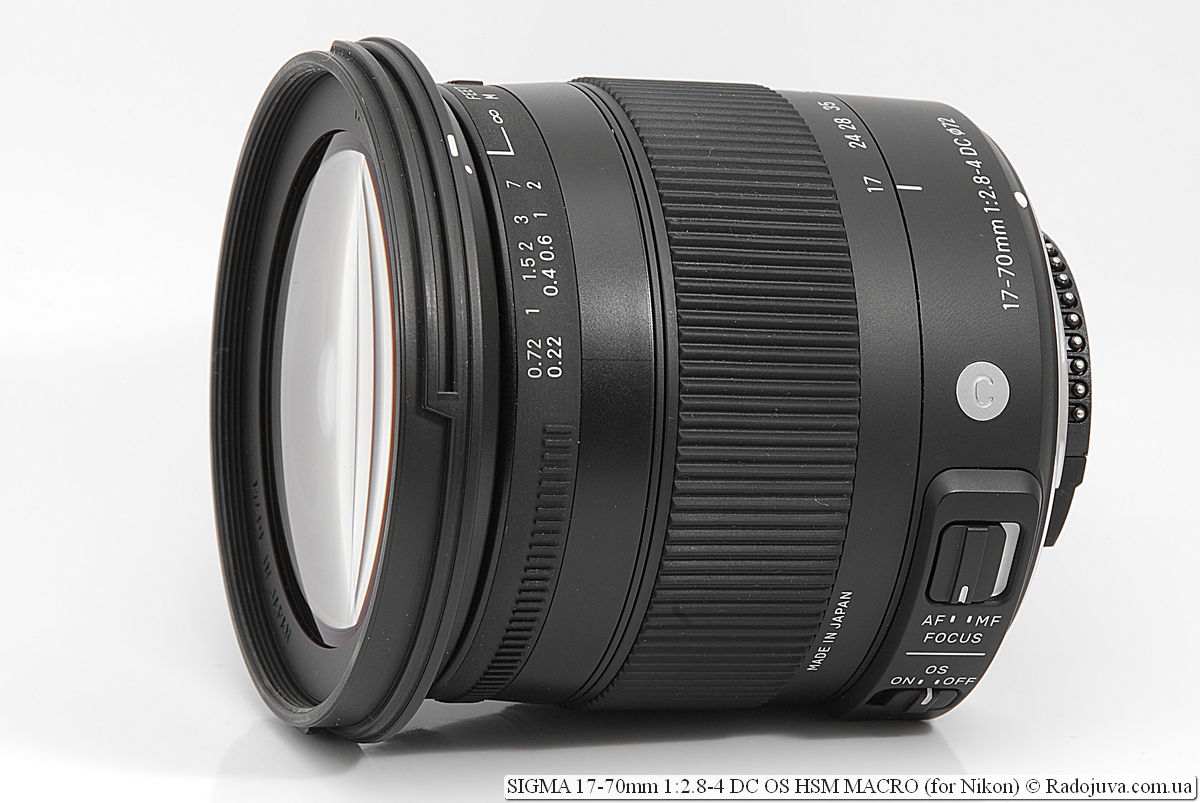

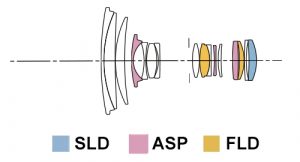
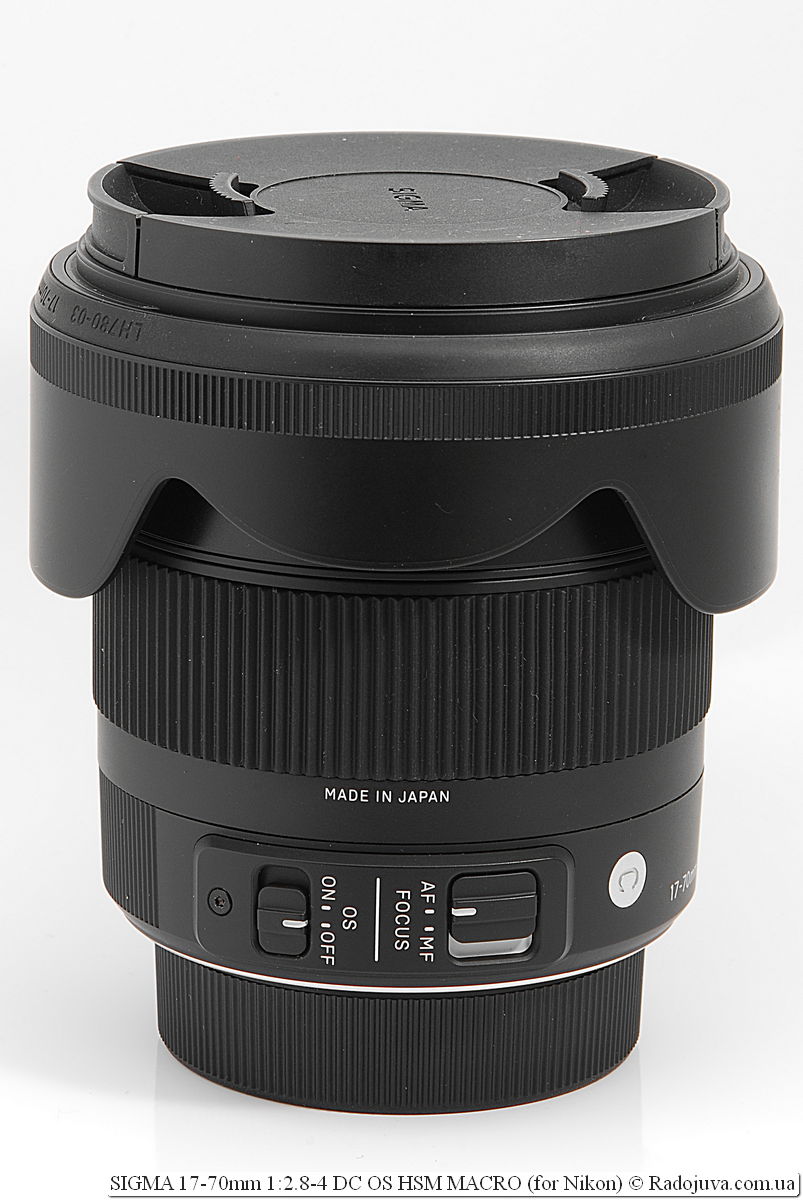
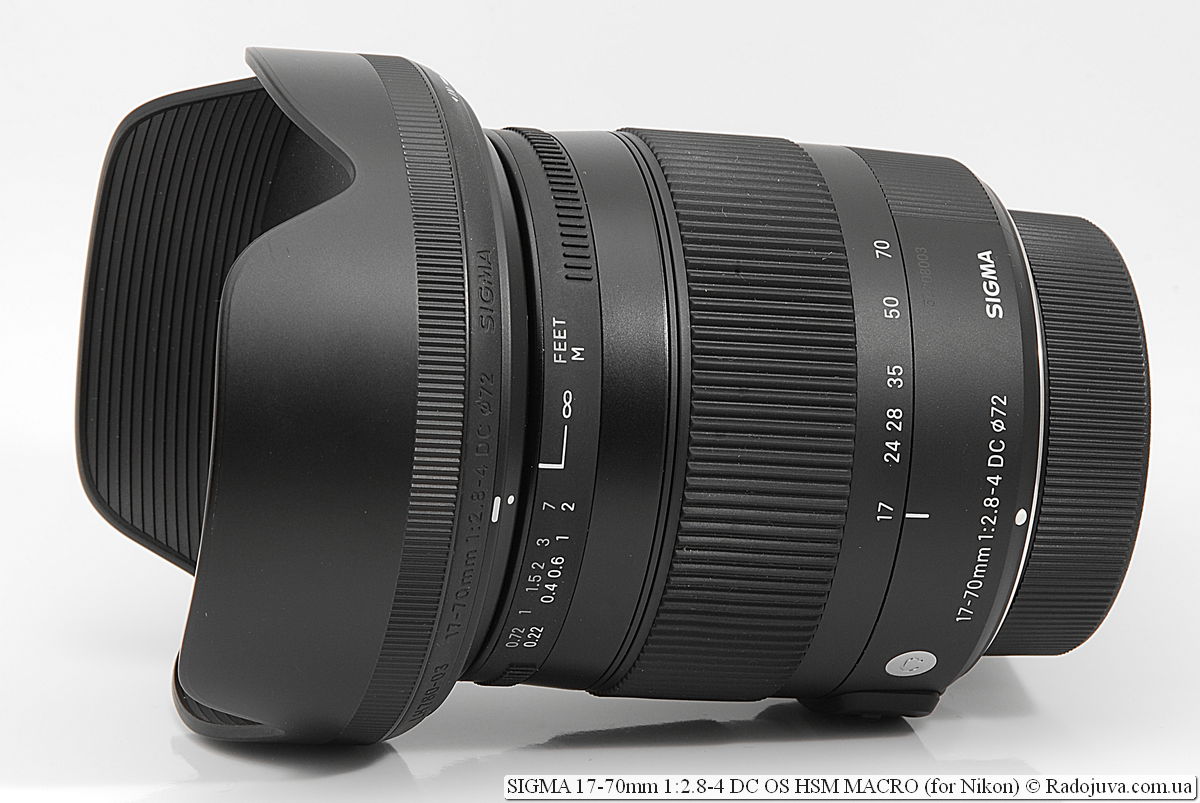
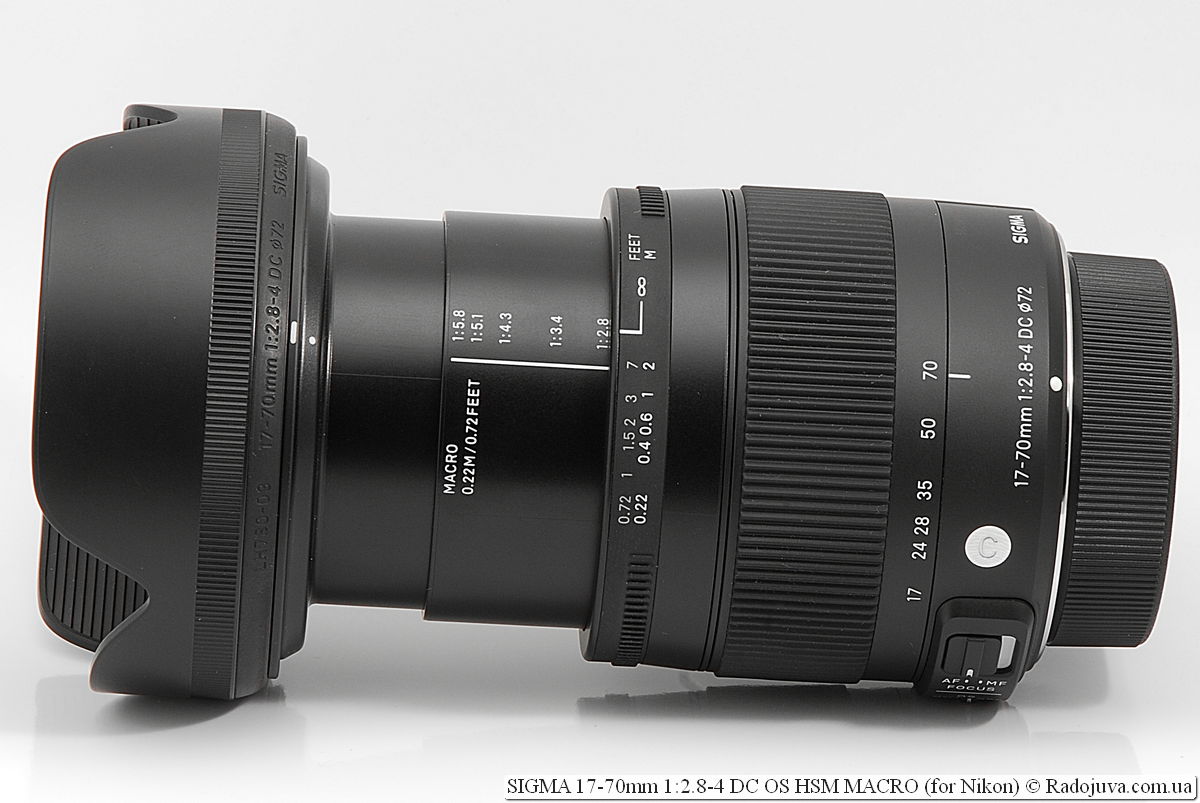
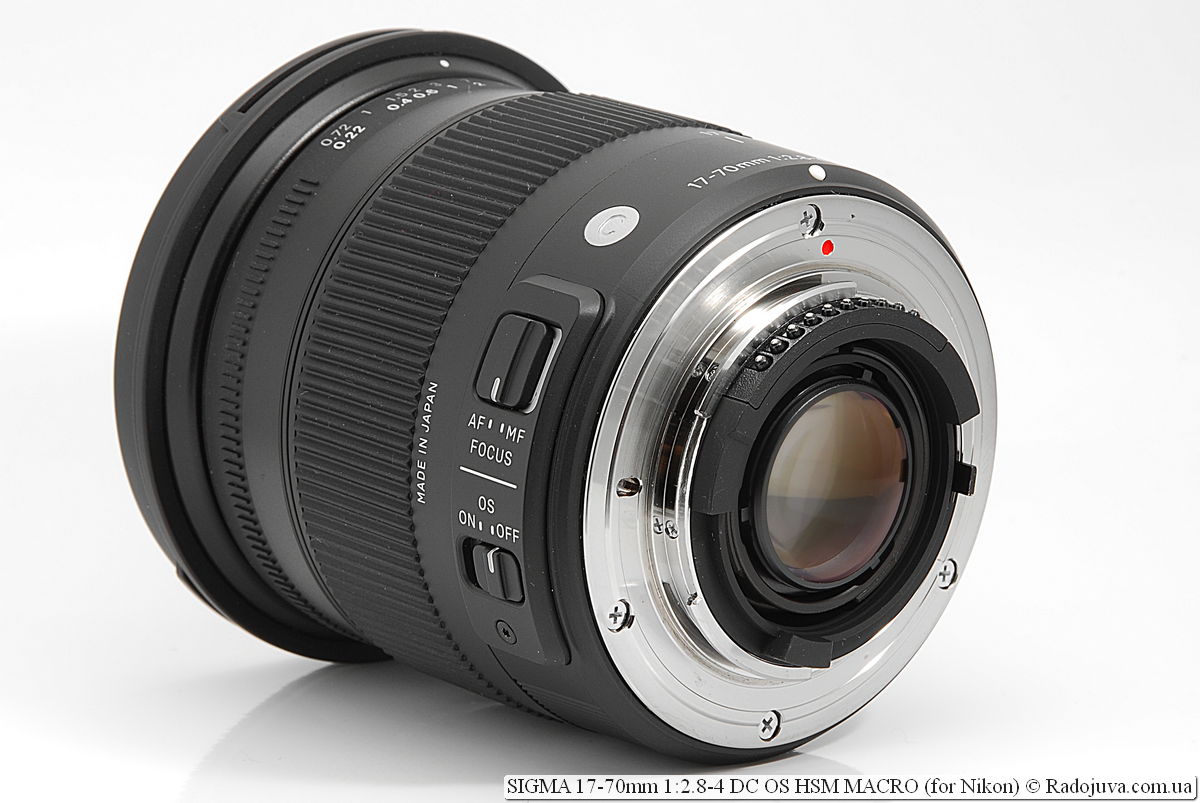

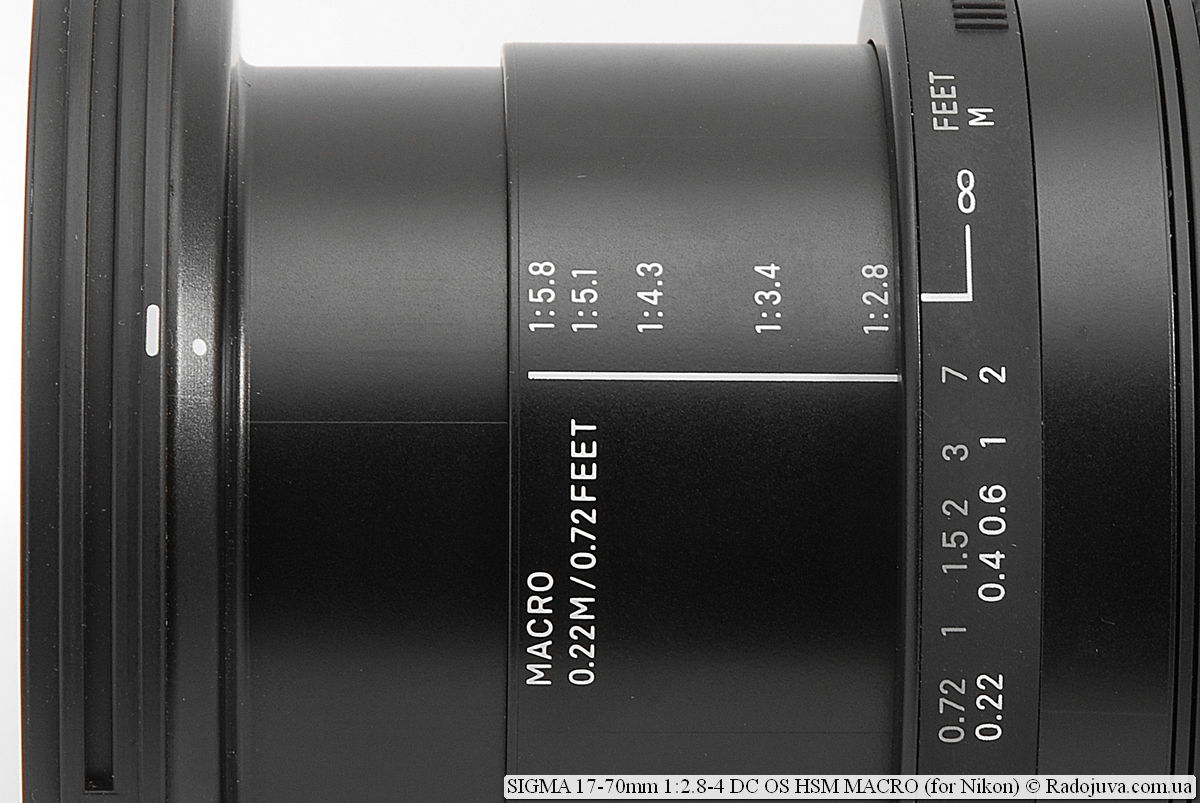



































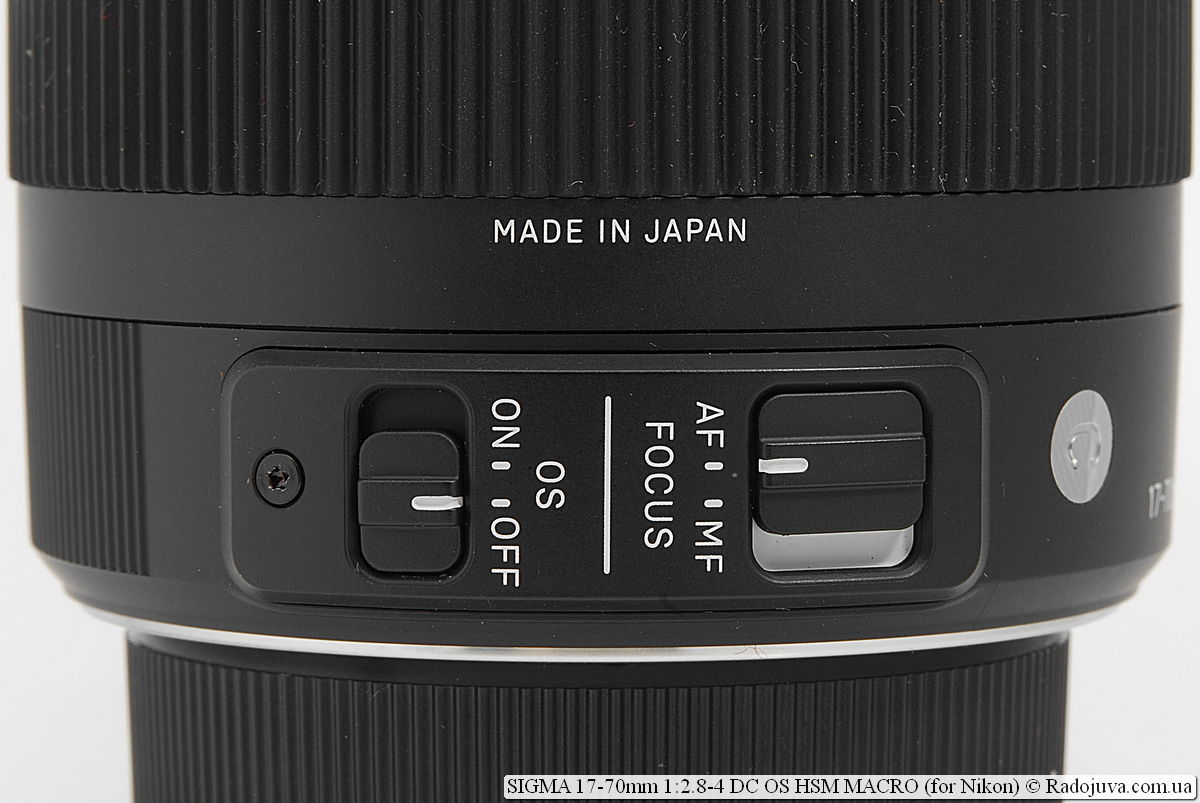
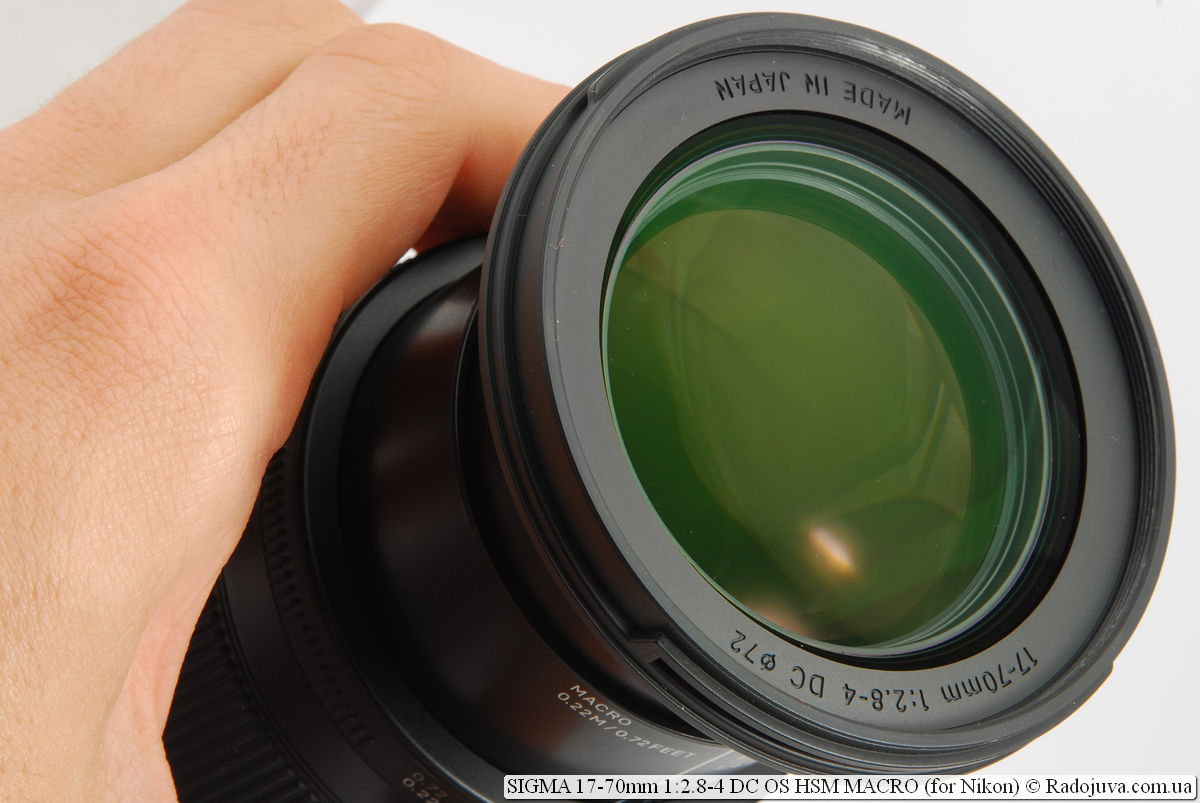

It's great that you shot on the D80) I love this device) Thank you!)
Duje garne slo
I have been waiting for this review for a long time ... But did not wait and bought my own 16-85.
You have made the right choice. 16-85 will be more ergonomic + filters cheaper.
Not only this. :)) For 16-85, the design will be better. And it is more uniform in the field of the frame in the sense of sharpness. And of course, MA when nothing rotates on the body.
And I have filters.
The 16-85 is a good lens, but f 4.0 by 70 mm is cool.
Same stabilizer behavior on Sigma 18-250 3.5-6.3 on carcasses D70 and D7100. Regardless of the switch, it always works.
hehhhh, plug. useless stabilizer at short focal lengths…. but as an alternative to native plugs, though - 500 bucks is serious money. it is better to take a used lens for growth - for Nikon 28-70 f2,8, for canon native 24-105 f4L - they will make this sikhma plug
But what about the wide angle?
a couple of steps back and that's okay)
It is not always possible to step back. For example, I recently went to the Oldcarfest exhibition. It was crowded with people, and after taking a couple of steps back, more passing onlookers got into the frame than the car being filmed. So it turned out that most of the photos were taken in the range of 18-24mm. And with 18-105VR, I'd be happy to sacrifice 20-25mm TV for 2-3mm wide. But this is a purely personal opinion, and much depends on the specific tasks, but personally, I often lack latitude rather than the television range in the standard zoom. Moreover, at least eat cheap TVs for crop, but there are no budget widths at all.
The lens is very “colorful”, like a photo after processing, saturated, rich colors. True, you always expect more "bumble" from a fast lens.
I don't like Sigma
I want such a lens))
He himself chose a lens for every day for the D5200. Almost a year going))
Compare this 17-70, Sigma 17-50 and Nikon 16-85. Several times I went to shops, took pictures, examined pictures at home. It’s only a pity that in one store there weren’t three of these lenses at once, I had to look in different ones.
16-85 comfortable lens, excellent construction. Focused for every day crop is generally ideal. Resolution is the worst of the three. And the main factor why he refused is the dark one. I want to film my child at home.
I really wanted 17-70 (focal lengths are convenient), but his resolution is worse than that of 17-50. Well, making a snapshot is not a problem.
I bought 17-50 in the end and I'm happy. An updated version with support for D5200 - no problems with focus and no glitches in the menu when viewing pictures.
The lens is completely nothing, it would cost 10 thousand new and second-hand in the range of 5-6 thousand. But for 25 thousand, few people will take such glass. Not only can you get a used 15-18 os sigma in excellent condition for 17-50, which is really fast and sharper, but for even less money you can take a tamron 17-50 2.8, albeit without a stub, but with 2.8 for all focal points. In my opinion, there is not much difference between this glass and a whale 18-55 or 18-105. At the same time, the price differs dramatically. If there are 25 thousand for this glass, then you can already think about switching to 17-55 2.8 native. Well, or take a few fixes to block these focal ones. If you take a used one, then you can take a width of sigma 10-20 for 13 thousand, plus 50 1.8d for 5, plus 35 1.8 for 6. In total, there will be a width and two excellent fixes with excellent sharpness and high aperture ... But there will be no universality, but this is the choice of each photographer.
Arkady's inspiration is again up to the mark! Excellent Arkady !!! The review is very comprehensive, competent and, most importantly, interesting. Probably the best view of the lens for a fairly long period. Very happy for you. In vain, I was disappointed in the review of the rangefinder lens JUPITER-12 1: 2.8 F = 3.5cm. Again interesting, fun to read. Keep it up!!!
I have been using this object for a year and a half as a regular one on the D7100, but much in the review was a discovery for me. I downloaded the NEF files of examples, I will study, look for sharpness at 17x2,8, chrome. an operation which I have not yet encountered in practice (on fixes 35x1,8G and 50x1,8D I can share this). I agree with Alexei in the comments about “colorfulness” - a minimum of work in native editors in this regard, although bokeh from aperture in my opinion should not be expected first of all, it’s better to pay attention to the long focus and the distance to the background from the point of it. And the trunk began to move out over time, if with a hood, this is a fact. falls, the mechanism can be brought back to its original state ... I don’t know. I have fixes 35 and 50, I set it in special cases, this one suits me quite well, although of course there is a difference, there’s nothing to argue about. Please do not judge strictly, this is the opinion of a amateur photographer.
HA in ravah is visible even without viewing 1 to 1 :). The noise of the stub is not described here as real noise interfering with shooting, but as confirmation of the work thereof and only if you listen very carefully.
Thanks Arkady. Well, you described everything :) My impressions about this lens are about the same - nice glass. I compared it with a whale 18-55, at the widest angle. I shot a landscape, from a tripod, without a stub, at f from 3,5 to 13. There is almost no difference with a whale in sharpness at f3,5, but when you close the aperture, up to f13, on this lens, sharpness increases significantly, at f13 it becomes approximately the same throughout the frame, and the kit 18-55 (my copy) does not give almost any, in comparison with this Sigma, sharpening at the edges of the frame. Tested on D3200. The rest of the corners are not touched. When working, I do not like the thin squeak of HSM, which is sometimes heard.
And the landscape at 3,5 is how to shoot so that it was sharply, or what?
It is possible on f / 3,5, but here it’s more likely for experiment
from the 9th floor if you shoot - the whole landscape is behind hyper focus :)
I use this glass as a staff member on Pentax kR and am quite pleased with it. I would not call it not sharp and noisy. Unsharpness is felt only at 17-20 mm. I didn’t hear any noise or squeak; when focusing, I hear a soft click. When choosing between the native Pentax DA 17-70 and the aforementioned Sigma, I chose the Sigma because of the lower price ($100), the presence of a macro, and the absence of complaints about the built-in motor. Both lenses are not dustproof. The Sigma has a larger light filter (72mm versus 67mm). My camera allows you to enter autofocus corrections, however, the corrections for 17 and 70 mm differ, I have to choose the average. For more flexible autofocus settings, you need to purchase a USB Dock station. By the way, this is another plus of this Sigma.
It's really cool. Contrast and sharpness at height (on the vіdminu vіd tamron 17-50 2.8 VR). I put f4 on the whole range and take a super sharp photo. Required bokeh - 70mm and portrait ready. Por_vnyano s 18-55 hours 18-105 - shortest short-term repair). Like an analogue of propon nikon 18-70 3,5-4,5G (with a slight stretch, if the marriage is pennies). R.S: Koristuvavsya with all the indicated lenses.
Good review.
I have been using this lens for a couple of years now as my main travel zoom. It shows itself very well, I'm satisfied with the purchase (camera - Nikon 3100).
I did not notice the described exit of the trunk before, now I specifically checked it - it is really observed with the manual focusing mode on (I only use afthofocus, as it turned out, there is also if it is directed vertically downward, but not as noticeably as with manual focusing). I'll keep it on mind.
I have 17-70 on the D7000, the glass does not really shine, it seems to me that even the 18-55 whale will be better, I would especially like to note hard mistakes at a long distance (most likely this is the problem of my copy) ... 2.8 aperture just so that it can be call it "fast" ... it's better to take 17-50
most likely this is the problem of your instance. In comparison with the whale 18-55 day and night. Sharpness on top!
or your 18-55 problem. he has good sharpness
useful review, specific comments, I have 18-140 and 35 f 1,8 I take off a little, I want a shirik-fix for the room, but so far there is no way
Which is more interesting in your opinion? 1-750 or this?
17-50*
I don’t understand what you found good at 17-50 and praise him. I took it for hire, especially with the exception of 2.8, but I took it like a traveluzum. And so the constant misses the focus, the battery eats like a turbine and the constant re-lights.!
The best cropped staffer for Nikon is my word of honor (I have the second version). I had a shock when I shot them on the D7100 after my native cetaceans. Already 3 years old - the longest present lens in the collection. I don't see any alternatives. Perfect sharpness across the entire field at a wide angle (a rarity for this price) from F7.1 and at F9-11 maximum at all focal lengths. Gorgeous colors and micro-contrast. Huge resolution - sometimes allows you to replace ultrazooms. With 70mm, you can get decent quality crop equivalents of 150 and 200 and even 300mm. These lenses do not reveal even half of the possibilities on ancient large-pixel matrices. Why not test on 24pm matrices?
I also have 17-70 for the third year, the version is not Contemporary, even on the D5100 it is much better than the whales, when I switched to the D7100 it became chic in general (the glass has a small back focus) A fairly good macro. A friend of mine has an old Canon and Sigma 17-50, so my pictures are noticeably sharper, all other things being equal, so maybe this glass really shows the best results on multi-pixel modern cameras.
All the shortcomings and jambs of the old versions of glasses were taken into account and corrected by the sigma company. It's written on the official site! And there is still such a tendency to choose lenses when buying .. From the first time, my copy came up like a native. instead of a whale. But the sharpness and contrast pleased. I use it exclusively as a travelZum traveled with him to the Crimea. Nikon 5100 17-70 2.8-4 put a solid “5”
Of course, choosing lenses when buying is very correct), but not always feasible. When I bought Sigma 17-70, it was in one copy, and the next time I would get to where it is possible to buy a lens only after a few months. I also have Nikkor 85 1.8G when I bought it, I checked it on the D7100, it hits it very accurately, but when I put this glass on the D750, I had to put an amendment of -12. With all this, Nikkor 70-300 on both carcasses “hit” right on target.
Yes, I quite agree. The lens is versatile. I am satisfied. But why did they put the lens 17-70 2,8-4 “3+” in the article for the fact that they do not really shoot landscapes?
I bought this lens today, though not “Contemporary” but the previous one.
the sound from the stabilizer really annoys me, in a room where nobody is there, I can hear it quite clearly. The stabilizer works very well, at shutter speed 1 \ 15 with it and without it, the difference is most noticeable.
You wrote that there is no latch that “holds” the trunk, so here it is, but it snaps into place only by 17mm :) that is, at 70mm I cannot fix it, and if I bring the lens up, it will slide! :)
Today he tested it on the street, everything is ok, but when I went into a warm room, the lenses were fogged up, it was about +7 on the street, it was very wet inside, really, and everything was foggy inside. Nevertheless, probably through the slits of the lens, it went very quickly. Condensation also disappeared very quickly when I went outside. So in extreme conditions it will not work.
My conclusion is this - for this money ($ 410) it could be better!
True, there is no alternative ... If you close your eyes to aesthetic inconveniences, such as the sound from the stabilizer and the stupid sliding of the lens (this will not happen in practice, unless you shoot stars from a tripod, then it will not work), then the lens is good. I tested it on 5200, it seems there were misses, but 5200 is not the right device to check such equipment, as I will buy a d7200, I will write another review.
I bought it as a replacement for 35 and 55 mm Nikon 1.8. Since 35 mm is under-landscape, and 50 mm is under-portrait.
And 17 mm and 70 mm are just what you need and you do not need to change every time. The price is 35 and 50 mm in the amount of $ 360 and there is no stabilizer - in reality, lubricants often come out.
While I see it is necessary to save money for more professional equipment, since the amateur level will always have various drawbacks ...
practically new. after use for about six months fell apart into two parts. it looks like the screws connecting them are either short or….
this lens with fuj
I want to buy a lens but I can’t decide which is better Sigma AF 17-70mm F2.8-4.0 DC MACRO OS HSM C (Nikon) or this SIGMA C (Contemporary) 17-70mm 1: 2.8-4 DC OS HSM MACRO what is described here